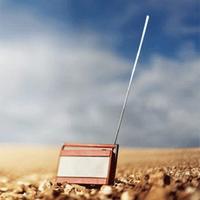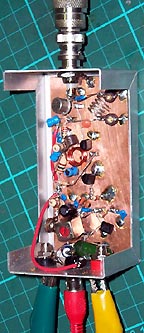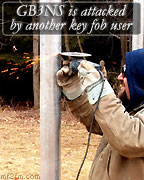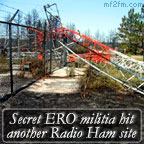Tuesday 1 April, 2008, 10:24 - Radio Randomness
Posted by Administrator
Posted by Administrator
 You've no doubt heard of pencil sharpeners and knife sharpeners, both designed to ensure the maximum of performance from the devices on which they operate. Well, on April 1 this year, researchers at the University of Al Tayr, in Tripoli, Libya released details of the results of a 5 year study that they have been conducting in which they believe they have discovered the world's first 'frequency sharpener'. Details are somewhat scant but if the device can deliver the kind of results that have been quoted in the research, the frequency sharpener could be being included in many new digital radios of the future as soon April of next year.
You've no doubt heard of pencil sharpeners and knife sharpeners, both designed to ensure the maximum of performance from the devices on which they operate. Well, on April 1 this year, researchers at the University of Al Tayr, in Tripoli, Libya released details of the results of a 5 year study that they have been conducting in which they believe they have discovered the world's first 'frequency sharpener'. Details are somewhat scant but if the device can deliver the kind of results that have been quoted in the research, the frequency sharpener could be being included in many new digital radios of the future as soon April of next year.In the University's press release, Prof. Ali Lo says of the frequency sharpener:
With weak signals, it is like a thousand camels standing through your receiver to blunt the sound. The frequency sharpener acts between these blunt and dull edges using a special digital encoded Saif Al Nisan algorithm that swipes away and cuts off the noise to leave only clear oasis of surrounding signal.
The release is rather thin on technical details of how the sharpener functions but goes on to claim:
Tests in laboratory of testing have shown, masha'allah, that 12 times improvement in frequency sharpness can be made to receive signal with almost no hump blockage in background or foreground. Works of programme suggest that remaining disturbance no worse than size of golden sand rabbits of similar proportion. By development, frequency sharpener will deliver 20 to 25 times decrease in annoyance of radio camel noise for new design of radio receiver in Arabian region. Better results with Saif Al Nisan algorithm than traditional threshold extension or synchronous detection methods employed before this discovery.
 We've sent an e-mail to the professor to see whether he could provide more information on how the frequency sharpener works, however from reading between the lines of the press release, we have been able to piece together how we think the device works:
We've sent an e-mail to the professor to see whether he could provide more information on how the frequency sharpener works, however from reading between the lines of the press release, we have been able to piece together how we think the device works:- The sharpener first stores ambient noise received when the wanted signal is gone, or from areas around the wanted signal.
- When required, this noise can be metabolised to act as a source of 'anti-noise' (similar to noise cancelling headphones) which cancels out the incoming 'live' received noise.
- This yields both a reduction in noise and, as a bi-product, generates spare energy that can be used to boost the wanted signal.
- The process of noise metabolisation generates a net reduction in both the stored and received noise, as well as amplifying the wanted signal.
- The system though, if it works as we suspect, requires the noise store to be 'topped up' from time-to-time. Once the noise store is empty (for example, if there is no longer noise on the received signal), the device returns to the normal state with no noise reduction taking place.
add comment
( 1751 views )
| permalink
| 



 ( 3.1 / 27330 )
( 3.1 / 27330 )




 ( 3.1 / 27330 )
( 3.1 / 27330 )
Thursday 13 March, 2008, 08:41 - Pirate/Clandestine
Posted by Administrator
Posted by Administrator
 Finding a frequency must be one of the most fraught tasks for any prospective London pirate radio operators. The band is now so crammed with stations that there are next to no gaps anywhere. The problem is not made any easier by the BBC using lots of frequencies to infill coverage of its local stations; nor by the new wave of community stations taking to the air. Now don't get me wrong, BBC, commercial and community radio stations have a licence and are authorised and legitimate users of the FM band and as such should be respected, and nothing hereinafter should be in any way taken as non-recognition of that important fact. But the fact also remains that pirate radio stations exist and are likely to continue to exist until technology renders them irrelevant and that finding a frequency that doesn't cause interference to these legitimate users, which is a goal to be aimed for if both legal and illegal stations are to co-exist, is nigh-on impossible.
Finding a frequency must be one of the most fraught tasks for any prospective London pirate radio operators. The band is now so crammed with stations that there are next to no gaps anywhere. The problem is not made any easier by the BBC using lots of frequencies to infill coverage of its local stations; nor by the new wave of community stations taking to the air. Now don't get me wrong, BBC, commercial and community radio stations have a licence and are authorised and legitimate users of the FM band and as such should be respected, and nothing hereinafter should be in any way taken as non-recognition of that important fact. But the fact also remains that pirate radio stations exist and are likely to continue to exist until technology renders them irrelevant and that finding a frequency that doesn't cause interference to these legitimate users, which is a goal to be aimed for if both legal and illegal stations are to co-exist, is nigh-on impossible. Since 2000 Ofcom (and its predecessor the Radiocommunications Agency) have been aware (through an oft overlooked study that examined the re-planning of the FM band) that there are small pockets of the FM band that could be used for low-power, limited geographical coverage transmitters in and around London, and it is the results of this study that are, to a large extent, enabling the licensing of the community stations. It's also interesting to note that many of these community stations are using frequencies that were esrtwhile used by pirates. Question: If they can now be used legally for such services without causing interference, can it be completely true that when being used illegally by pirates that the interference they cause was really so bad? Well the power of the community stations is typically less than 100 Watts and they are specifically located in areas where the frequencies they use will not cause interference, whereas the pirates on the same frequencies were often using 250 Watts or more in an attempt to cover a much wider, or a different, area. So it is quite likely that the pirates did cause interference in some areas, but clearly not in others.
Since 2000 Ofcom (and its predecessor the Radiocommunications Agency) have been aware (through an oft overlooked study that examined the re-planning of the FM band) that there are small pockets of the FM band that could be used for low-power, limited geographical coverage transmitters in and around London, and it is the results of this study that are, to a large extent, enabling the licensing of the community stations. It's also interesting to note that many of these community stations are using frequencies that were esrtwhile used by pirates. Question: If they can now be used legally for such services without causing interference, can it be completely true that when being used illegally by pirates that the interference they cause was really so bad? Well the power of the community stations is typically less than 100 Watts and they are specifically located in areas where the frequencies they use will not cause interference, whereas the pirates on the same frequencies were often using 250 Watts or more in an attempt to cover a much wider, or a different, area. So it is quite likely that the pirates did cause interference in some areas, but clearly not in others. One of the interesting side-effects of this use of previous 'pirate' frequencies by the new community stations is that the pirates have been forced to take action to try and maintain their coverage and listenership without causing (too many) problems to the new stations. Blasting several hundred Watts over the top of a new community stations is the perfect recipe to get busted. Hats off, therefore, to Passion FM who, having been forced off their long-time frequency of 91.8 MHz by community station Hayes FM in West London, have taken to using two different frequencies, with directional antennas, to protect Hayes FM yet maintain their service area. Passion can now be found in East London on 91.8 MHz and in West London on 97.9 MHz, thereby making an effort not to interfere with Hayes FM at the expense of having two lots of transmitters to replace each time they are taken off-air.
One of the interesting side-effects of this use of previous 'pirate' frequencies by the new community stations is that the pirates have been forced to take action to try and maintain their coverage and listenership without causing (too many) problems to the new stations. Blasting several hundred Watts over the top of a new community stations is the perfect recipe to get busted. Hats off, therefore, to Passion FM who, having been forced off their long-time frequency of 91.8 MHz by community station Hayes FM in West London, have taken to using two different frequencies, with directional antennas, to protect Hayes FM yet maintain their service area. Passion can now be found in East London on 91.8 MHz and in West London on 97.9 MHz, thereby making an effort not to interfere with Hayes FM at the expense of having two lots of transmitters to replace each time they are taken off-air. West Londoners Point Blank FM also deserve a mention. They are broadcasting to South West London on 103.6 MHz (and thus avoiding Life FM in Harlesden, North London and TGR Sound on 103.7 MHz in South East London) and to Central London on 90.2 MHz, having moved off 108.0 MHz where they used to cause undue interference to Radio Jackie on 107.8 MHz. 108.0 is now used by Unknown FM whose service area, being further East causes fewer problems to Jackie. Both Passion FM and Point Blank FM use the correct RDS Alternative Frequency ('AF') flag so that listeners driving around London will automatically be re-tuned to the clearest frequency - smart! Freeze FM are also 'dual-casting' on 92.7 and 99.5 MHz - it's not clear why but possibly one of the community stations yet to come on-air (Radio Ummah and Irish FM) may use a frequency near 92.7.
West Londoners Point Blank FM also deserve a mention. They are broadcasting to South West London on 103.6 MHz (and thus avoiding Life FM in Harlesden, North London and TGR Sound on 103.7 MHz in South East London) and to Central London on 90.2 MHz, having moved off 108.0 MHz where they used to cause undue interference to Radio Jackie on 107.8 MHz. 108.0 is now used by Unknown FM whose service area, being further East causes fewer problems to Jackie. Both Passion FM and Point Blank FM use the correct RDS Alternative Frequency ('AF') flag so that listeners driving around London will automatically be re-tuned to the clearest frequency - smart! Freeze FM are also 'dual-casting' on 92.7 and 99.5 MHz - it's not clear why but possibly one of the community stations yet to come on-air (Radio Ummah and Irish FM) may use a frequency near 92.7.Pirates are often accused of not caring about interference to other stations, but the actions of these stations would tend to suggest that they do take some care - not least, perhaps, to protect themselves from an excessive number of raids from the authorities.
For the record, other pirate/community frequency clashes that will no doubt resolve themselves in the end are Westside FM (Southhall, West London) and Select-UK (Rotherhithe, South London), both on 89.6 MHz, Nu-Sound (Forest Gate, East London) and Powerjam (Battersea, South London) on 92.0 MHz, and Voice of Africa (Newham, East London) and Tempo on 94.3 and 94.4 MHz respectively.
Tuesday 11 March, 2008, 09:08 - Spectrum Management
Posted by Administrator
Posted by Administrator
 To add to the previous list of frequencies for London Heathrow, Gatwick and City that went before, here is a set of active frequencies for Farnborough (ICAO code: EGLF) which might come in handy for the 2008 airshow. All frequencies are in MHz and use AM. Those shown in italics are unconfirmed but are listed widely enough to indicate that they are highly likely to remain current.
To add to the previous list of frequencies for London Heathrow, Gatwick and City that went before, here is a set of active frequencies for Farnborough (ICAO code: EGLF) which might come in handy for the 2008 airshow. All frequencies are in MHz and use AM. Those shown in italics are unconfirmed but are listed widely enough to indicate that they are highly likely to remain current.London Farnborough Airport
Radar 125.250
Radar Standby 130.050
Approach 134.350
Tower 122.500
Operations 130.375 (TAG Handling)
ATIS 128.400
One additional frequency of note is 444.3375 MHz (FM not AM), which is a local repeat of the tower and is interestingly in the 443.500 to 445.500 MHz Ministry of Defence (MoD) sub-band. Presumably this is assignment a hang-over from when the airport undertook more military operations than it does now.
Monday 10 March, 2008, 18:25 - Amateur Radio
Posted by Administrator
<rant> Whilst visiting Oxford this week, a quick scan around the 70cm band yielded a number of repeaters that aren't normally receiveable from my regular location. Amongst these was GB3WO, near Witney in Oxfordshire. Nothing unusual there. Except that upon setting the right CTCSS tone and firing up the repeater, it was distressing to find that it remained open and was emitting a horrid buzzing/whining noise like someone was attacking it with a chainsaw. The culprit for the noise was clearly one of the many low-power licence-exempt data links used for devices such as weather stations, doorbells and the like.Posted by Administrator
 I've already discussed the issue of allowing these devices into the UK 70cm repeater band and poor GB3WO was suffering the consequences (of course, the addition of a requirement for all transmissions to have CTCSS as some repeater operators have done would help the situation but would not stop the repeater input being jammed by such a device, only stop it being relayed). I've also recently highlighted the problems of being a secondary user in the 70cm band and the associated difficulties in getting interference dealt with.
I've already discussed the issue of allowing these devices into the UK 70cm repeater band and poor GB3WO was suffering the consequences (of course, the addition of a requirement for all transmissions to have CTCSS as some repeater operators have done would help the situation but would not stop the repeater input being jammed by such a device, only stop it being relayed). I've also recently highlighted the problems of being a secondary user in the 70cm band and the associated difficulties in getting interference dealt with. But it seems that the problem is getting even worse. Repeater GB3NS in Banstead, Surrey had to be taken off-air because of these low power devices. It used to operate on RB10 (output frequency of 433.250 MHz) but was forced to cease operation when it was shown that it was causing blocking of car key-fob receivers in a nearby car-park which was in turn causing the car rescue organisations to be repeatedly called out to cars that wouldn't open or start. It was eventually shown, following practical on-air tests, that a change to a 70cm wide-space (7.6 MHz split) channel assignment circumvented the problem and eventually 'NS was re-licensed and radio hams can now use this repeater again (output is on 430.925 MHz and input on 438.525 MHz which also keeps the input frequency thankfully free of these annoyances). So this is a real example of a secondary user of a band being forced to cease transmissions to protect a tertiary or non-interference basis 'NIB' user - clearly in this band, radio amateurs are not just second-class citizens but have no rights at all.
But it seems that the problem is getting even worse. Repeater GB3NS in Banstead, Surrey had to be taken off-air because of these low power devices. It used to operate on RB10 (output frequency of 433.250 MHz) but was forced to cease operation when it was shown that it was causing blocking of car key-fob receivers in a nearby car-park which was in turn causing the car rescue organisations to be repeatedly called out to cars that wouldn't open or start. It was eventually shown, following practical on-air tests, that a change to a 70cm wide-space (7.6 MHz split) channel assignment circumvented the problem and eventually 'NS was re-licensed and radio hams can now use this repeater again (output is on 430.925 MHz and input on 438.525 MHz which also keeps the input frequency thankfully free of these annoyances). So this is a real example of a secondary user of a band being forced to cease transmissions to protect a tertiary or non-interference basis 'NIB' user - clearly in this band, radio amateurs are not just second-class citizens but have no rights at all. Worst still, through an almighty lack of foresight, many of the new, digital D-Star repeaters have been given frequency assignments with an input frequency of 433.9125 MHz - just 7.5 kHz down from the 'centre' of the low-power licence-exempt band. Interference at this frequency is so bad that one repeater has already had to be taken off-air until a new assignment can be allocated, as the following press-release tells:
A newly operational D-Star repeater in the United Kingdom has been forced off the air due to interference on its input from unlicensed devices. The Radio Society of Great Britain's Emerging Technology Co-ordination Committee website reports that the GB7YD-C, 70cm D-Star system has been removed from service until an alternative frequency can be found. According to the coordinating committee, problems have been experienced at other United Kingdom 70 cm D-Star repeaters with an input on 433.9125 MHz.
The most annoying aspect of this situation is that the rules under which these low-power licence-exempt devices operate require them to accept any interference that they might experience, and not to cause any interference to licenced users of the frequencies on which they operate. Yet (in the UK at least) they are being given privileges that are greater than that of secondary users whose status is legally higher. They are certainly becoming more than just a noisy annoyance, but can anything be done to rectify the situation?
A review conducted by the European Radiocommunications Office, known as the Detailed Spectrum Investigation Phase II (DSI 2) and published on 13 March 1995 (i.e. 13 years ago) specifically recommended:
… an allocation be agreed for a general low power band at 403-404.5 MHz intended for new applications and to avoid placing new equipment at 433 MHz unless absolutely essential, the 433 MHz band to be subject to a general review at an appropriate time.
It made this recommendation because:
Amateurs in CEPT countries, particularly suffer from ISM interference in the 433.92 MHz ISM band. Similarly manufacturers of low power systems using this band are concerned at the interference potential of amateur emissions.
So this problem was identified, and a solution proposed, so long ago that it could now be something of the past. Obviously something has changed at the ERO, who now seem intent upon converting radio amateurs (who have been responsible for much of the propagational and technical research and innovation that drives today's wireless industry) into operators who can do little more than clean up the sweepings on the spectrum floor and be content with any titbits they might be thrown. Might this change of heart be something to do with the fact that at the time of the DSI, the head of the ERO was a radio amateur (OZ3SDL) but it is now headed by Mark Thomas, ex-Ofcom, a man who abolished the minimum bit-rate for UK DAB radio services and of whom Google brings up the thoughts (check for yourself if you don't believe me):
Gone to ERO in Denmark, and good bloody riddance …
 So, it seems, radio amateurs are right royally stuffed! Having realised this, one thought springs to mind - why not take away lots of the amateur bands that are lightly used (30m, 12m, 23cm, 13cm, 9cm and so on) and instead allow amateurs to 'roam free', and use any frequency that is otherwise available. This is the concept being argued for by proponents of cognitive radio, whereby sensitive receivers sweep available frequencies to identify unused ones and then communicate on those - if a transmission on that frequency is later detected the cognitive radio senses this and moves elsewhere. Now amateur radio systems are almost all set up with the intention of being able to detect weak signals, and thus if any frequency appears unused at a given location, there's a fair chance that it is unused in that neighbourhood. And instead of being controlled by software, an 'amateur cognitive' transmitter would be controlled by a living, thinking person with a respect for the radio spectrum and its users. Indeed amateurs could once again be at the forefront of technology by conducting real-life assessments of the potential for cognitive radios to cause interference and thus informing the wider discussion on the use of such devices.
So, it seems, radio amateurs are right royally stuffed! Having realised this, one thought springs to mind - why not take away lots of the amateur bands that are lightly used (30m, 12m, 23cm, 13cm, 9cm and so on) and instead allow amateurs to 'roam free', and use any frequency that is otherwise available. This is the concept being argued for by proponents of cognitive radio, whereby sensitive receivers sweep available frequencies to identify unused ones and then communicate on those - if a transmission on that frequency is later detected the cognitive radio senses this and moves elsewhere. Now amateur radio systems are almost all set up with the intention of being able to detect weak signals, and thus if any frequency appears unused at a given location, there's a fair chance that it is unused in that neighbourhood. And instead of being controlled by software, an 'amateur cognitive' transmitter would be controlled by a living, thinking person with a respect for the radio spectrum and its users. Indeed amateurs could once again be at the forefront of technology by conducting real-life assessments of the potential for cognitive radios to cause interference and thus informing the wider discussion on the use of such devices.Maybe, just maybe, taking some action now might return amateur radio and its users to a position of innovation and respect amongst the wider radio community instead of just being viewed as bolshy CB operators? </rant>


